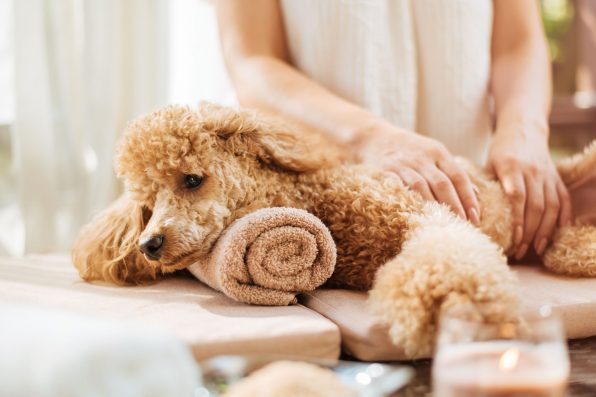Canine Massage Can Relieve Your Pup’s Pain And Boost Their Quality Of Life

Massages are coveted commodities for us humans, so you may have never considered giving your dog their own version of this spa treatment.
Yet, a good rub down can actually be very beneficial for any canine, not just pampered pups. Massages are great ways to help your dog deal with pain, recover from injuries or surgeries, and reduce stress.
Here’s everything you need to know about canine massage and how to decide if it’s right for your furry friend.
Canine Massage
Massages for dogs aren’t much different from those for people. They involve manipulating the soft tissue with a range of techniques, including pressing, kneading, and tapping and may increase circulation, reduce pain, and help mobility.
There are psychological upsides as well since canine massage can lower anxiety and stress among our pups.
“Massage is an underutilized but valuable tool to maintain or restore function in your canine companion. Not only does it help reduce pain, make muscles more supple and limber, and assist your dog in returning to activities they love, but it also plays a crucial role in strengthening the bond with your faithful friend,” explained Dr. Sarah Blotevogel, a certified canine massage and rehabilitation specialist.
In terms of temperament, these treatments can keep your pup happy, too. Think about it: if you’ve ever been in pain, was your mood adversely affected? Your dog is no different.
So, canine massage may help mitigate the behavioral changes that come along with physical symptoms, such as lethargy or depression.

Rasulov – stock.adobe.com – illustrative purposes only, not the actual person or dog
One study published in Vet Record, which included 527 dogs undergoing massage therapy, even found that a dog was more likely to lead a better quality of life after treatment. The study’s authors concluded that canine massage could be a viable option for pain associated with arthritis, muscular injuries, and additional orthopedic conditions.
Are Massages Right For Your Dog?
Practically all pups can benefit from this. From dog athletes who complete agility courses to senior canines or those recovering from an operation, massages have the ability to decrease stiffness and improve range of motion.
They’re great for puppies, too, teaching your juvenile pet to view touch as a welcomed, positive experience. That association can make future visits to the groomer or veterinarian much less frightening.
If you’re interested in finding a canine massage therapist, your first step should be researching your state’s laws, as there are some regulations that must be followed. In your area, you may need to get a referral from your veterinarian first, and your vet might have to supervise the massage sessions.
Then, when speaking with potential massage therapists, verify that their certifications have been obtained from a reputable organization. For instance, via a preferred educational provider with the International Association of Animal Massage and Bodywork.
Can You Massage Your Furry Friend At Home?
There are some simple massage methods that pet owners can learn to perform at home, either through in-person or online classes.
One basic technique to get you started is known as “effleurage,” in which you rub using a long stroke. You can begin at your dog’s head, using hand-over-hand motions to rub your way down their back and legs to the tail.
As you do this, you can incorporate circular motions as well, using flat hands as you travel from your pup’s head down to their tail.
Provide your pet with a quiet, relaxing environment that’s free from distractions during the massage for the best experience. Just don’t use too much power or force your dog to stay when they’re finished, as this can create negative associations with the treatment.
Sign up for Chip Chick’s newsletter and get stories like this delivered to your inbox.
More About:Animals





